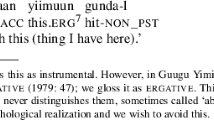Abstract
Within unilevel theories of grammar like Generalized Phrase Structure Grammar, there has been considerable attention paid to the development of a coherent theory of Feature Percolation. Within Government and Binding Theory, however, this matter has received less attention. In this paper, we argue that the incorporation within GBT of a simple set of principles governing Feature Percolation provides a general treatment of diverse phenomena. We concentrate on how a theory of Feature Percolation can simplify various aspects of the description of long distance reflexives in Chinese, Korean and other languages.
Similar content being viewed by others
References
Anderson, Stephen (1986) “The Typology of Anaphoric Dependencies: Icelandic (and Other) Reflexives,” in Lars Hellan and Kirsti Kroch Christensen (eds.),Topics in Scandinavian Syntax, Reidel, Dordrecht.
Battistella, Edwin (1989) “Chinese Reflexivization: A Movement to INFL Approach,”Linguistics 27, 987–1012.
Chomsky, Noam (1985)Knowledge of Language: its Nature, Origin and Use, Praeger, New York.
Cole, Peter and Li-May Sung (1991) “Head Movement and Long Distance Reflexives,” to appear in LI.
Cole, Peter, Gabriella Hermon, and Li-May Sung (1990) “Principles and Parameters of Long Distance Reflexives,”Linguistic Inquiry 21, 1–22.
Cowper, Elizabeth (1987) “Pied Piping, Feature Percolation and the Structure of the Noun Phrase,”Canadian Journal of Linguistics 34.
Gazdar, Gerald, Ewan Klein, Geoffrey Pullum, and Ivan Sag (1985)Generalized Phrase Structure Grammar, Harvard University Press, Cambridge.
Giorgi, Alessandra (1984) “Toward a Theory of Long Distance Anaphora: A GB Approach,”The Linguistic Review 3, 307–359.
Grimshaw, Jane (1991) “Extended Projection,” unpublished manuscript, Brandeis University.
Harbert, Wayne (1990) “Subjects of Prepositions,” unpublished manuscript, Cornell University.
Hermon, Gabriella (1992) “Binding Theory and Parameter Setting,” (to appear inThe Linguistic Review).
Hermon, Gabriella and James Yoon (in preparation) “Agreement Parameters and Prodrop,” University of Delaware and University of Illinois.
Huang, C.-T. James and C.-C. Jane Tang (1988) “On the Local Nature of the Long-Distance Reflexive in Chinese,”Proceedings of NELS 18. GLSA. Department of Linguistics, University of Massachusetts.
Huang, Y.-H. (1984) “Reflexive in Chinese,” inStudies in English Literature and Linguistics 10, 163–168.
Kang, Beom-Mo (1988) “Unbounded Reflexives,”Linguistics and Philosophy 11, 415–456.
Lightfoot, David (1989) “The Child's Trigger Experience: Degree 0 Learnability,”Behavioral and Brain Sciences 12, 321–375.
Maling, Joan (1984) “Non-Clause-Bound Reflexives in Modern Icelandic,”Linguistics and Philosophy 7.
Manzini, Rita and Kenneth Wexler (1987) “Parameters, Binding Theory, and Learnability,”Linguistic Inquiry 18, 413–444.
Napoli, Donna Jo (1979) “Reflexivization across Clause Boundaries in Italian,”Journal of Linguistics 15, 1–27.
Pica, Pierre (1984) “Subject, Tense and Truth: Toward a Modular Approach to Binding,” in Jacqueline Gueron, Hans-Georg Obenauer, and Jean-Yves Pollock (eds.),Grammatical Representation, Foris, Dordrecht.
Pica, Pierre (1984) “On the Nature of the Reflexivization Cycle,”Proceedings of NELS 17, GLSA, Department of Linguistics, University of Massachusetts.
Pollard, Carl and Ivan Sag (1987)Information-Based Syntax and Semantics. Vol. 1, CSLI, Stanford.
Rappaport, Gilbert (1986) “On Anaphor Binding in Russian,”Natural Language and Linguistic Theory 4, 97–120.
Sung, Li-May (1990)Universals of Reflexives, PhD dissertation, University of Illinois.
Tang, C.-C. Jane (1989) “Chinese Reflexives,”Natural Language and Linguistic Theory 7, 93–121.
Webelhuth, Gert (1989)Syntactic Saturation Phenomena and the Modern German Languages, PhD dissertation, University of Massachusetts.
Yoon, Jeog-Me (1988) “Single and Compound Reflexives in Korean,” unpublished manuscript, University of Illinois.
Author information
Authors and Affiliations
Additional information
This paper is one of a number of works reporting on research on long distance reflexives and related topics carried out by Peter Cole, Gabriella Hermon, and Li-May Sung at the University of Delaware. The authors each participated equally in the preparation of the papers. The order of names does not represent greater or lesser participation in the papers or the research on which they are based.
Earlier versions of this work have been presented to a variety of audiences, among them the linguistic colloquia of SUNY Buffalo and UCLA, the Hungarian National Academy of Sciences, the Jersey Syntax Circle, the Linguistic Research Seminar of the University of Geneva, and the Workshop on East Asian Linguistics (University of California at Irvine). Among the many individuals whose comments have contributed to our understanding, we would particularly like to thank Janet Dean Fodor, Wayne Harbert. Arild Hestvik, Jim Huang, Istvan Kenesei, Audrey Li, Robert May, K. P. Mohanan, Jerry Morgan, Dick Oehrle, Tanya Reinhart, Ken Safir, Sue Steele, Luigi Rizzi, Ian Roberts, Tim Stowell, Sten Vikner, Raffaella Zanuttini, and the anonymous E A L referees. Special thanks go to James Yoon, with whom we discussed many of the issues in this paper extensively. Our discussion of Korean is largely adapted from his analyses and those of J.-M. Yoon. We would also like to thank Chengchi Wang for his comments and for his help in preparing the manuscript for publication. The research reported here was supported in part by funds from the College of Arts and Sciences of the University of Delaware and by the National Science Foundation, grant number BNS-9121167.
Rights and permissions
About this article
Cite this article
Cole, P., Hermon, G. & Sung, LM. Feature Percolation. J East Asian Linguis 2, 91–118 (1993). https://doi.org/10.1007/BF01440584
Received:
Revised:
Issue Date:
DOI: https://doi.org/10.1007/BF01440584




